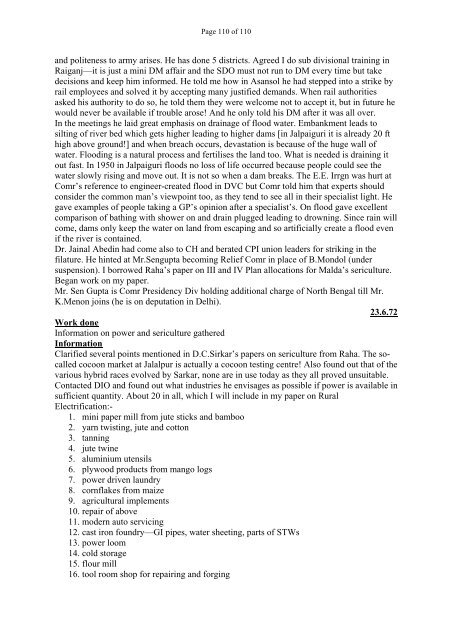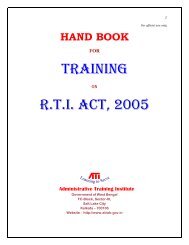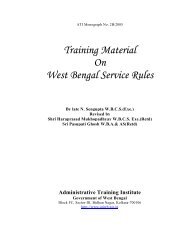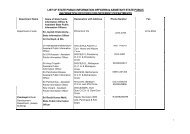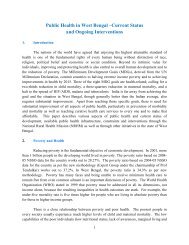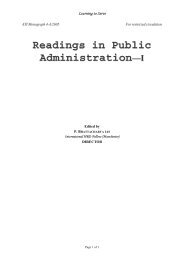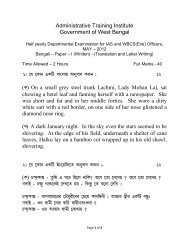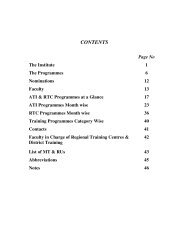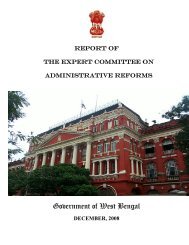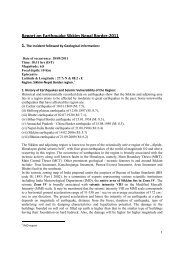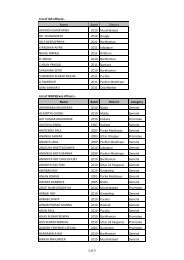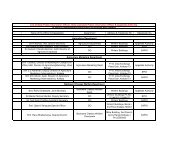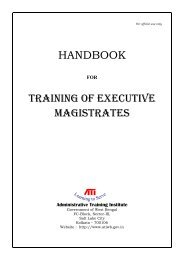Malda Training Diary - Administrative Training Institute
Malda Training Diary - Administrative Training Institute
Malda Training Diary - Administrative Training Institute
Create successful ePaper yourself
Turn your PDF publications into a flip-book with our unique Google optimized e-Paper software.
Page 110 of 110<br />
and politeness to army arises. He has done 5 districts. Agreed I do sub divisional training in<br />
Raiganj—it is just a mini DM affair and the SDO must not run to DM every time but take<br />
decisions and keep him informed. He told me how in Asansol he had stepped into a strike by<br />
rail employees and solved it by accepting many justified demands. When rail authorities<br />
asked his authority to do so, he told them they were welcome not to accept it, but in future he<br />
would never be available if trouble arose! And he only told his DM after it was all over.<br />
In the meetings he laid great emphasis on drainage of flood water. Embankment leads to<br />
silting of river bed which gets higher leading to higher dams [in Jalpaiguri it is already 20 ft<br />
high above ground!] and when breach occurs, devastation is because of the huge wall of<br />
water. Flooding is a natural process and fertilises the land too. What is needed is draining it<br />
out fast. In 1950 in Jalpaiguri floods no loss of life occurred because people could see the<br />
water slowly rising and move out. It is not so when a dam breaks. The E.E. Irrgn was hurt at<br />
Comr’s reference to engineer-created flood in DVC but Comr told him that experts should<br />
consider the common man’s viewpoint too, as they tend to see all in their specialist light. He<br />
gave examples of people taking a GP’s opinion after a specialist’s. On flood gave excellent<br />
comparison of bathing with shower on and drain plugged leading to drowning. Since rain will<br />
come, dams only keep the water on land from escaping and so artificially create a flood even<br />
if the river is contained.<br />
Dr. Jainal Abedin had come also to CH and berated CPI union leaders for striking in the<br />
filature. He hinted at Mr.Sengupta becoming Relief Comr in place of B.Mondol (under<br />
suspension). I borrowed Raha’s paper on III and IV Plan allocations for <strong>Malda</strong>’s sericulture.<br />
Began work on my paper.<br />
Mr. Sen Gupta is Comr Presidency Div holding additional charge of North Bengal till Mr.<br />
K.Menon joins (he is on deputation in Delhi).<br />
23.6.72<br />
Work done<br />
Information on power and sericulture gathered<br />
Information<br />
Clarified several points mentioned in D.C.Sirkar’s papers on sericulture from Raha. The socalled<br />
cocoon market at Jalalpur is actually a cocoon testing centre! Also found out that of the<br />
various hybrid races evolved by Sarkar, none are in use today as they all proved unsuitable.<br />
Contacted DIO and found out what industries he envisages as possible if power is available in<br />
sufficient quantity. About 20 in all, which I will include in my paper on Rural<br />
Electrification:-<br />
1. mini paper mill from jute sticks and bamboo<br />
2. yarn twisting, jute and cotton<br />
3. tanning<br />
4. jute twine<br />
5. aluminium utensils<br />
6. plywood products from mango logs<br />
7. power driven laundry<br />
8. cornflakes from maize<br />
9. agricultural implements<br />
10. repair of above<br />
11. modern auto servicing<br />
12. cast iron foundry—GI pipes, water sheeting, parts of STWs<br />
13. power loom<br />
14. cold storage<br />
15. flour mill<br />
16. tool room shop for repairing and forging


